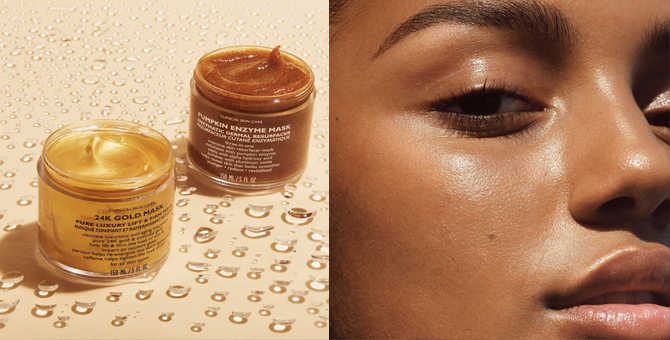Maybe you associate exfoliating with red, raw skin, thanks to the apricot face scrub you’ve been using for the last 10 years. Maybe your skin is a little on the sensitive side and you’re averse to the AHA, BHA, PHA variety of exfoliants. Or, maybe you’re just a skincare buff who has tried it all, and you’re now curious about the new exfoliant on the block.
Well, welcome to the world of enzymes—they are no longer just the nifty biological molecules that keep you alive and help you digest. No, they’re in your skincare now, and if you’re on the sensitive side, they might just be what you’re looking for. For the low-down on all things enzymatic, read on.
What are enzyme exfoliants?
Think of them as your chemical exfoliant‘s timid half-sibling; they both kind of work in adjacent ways, but they’re not exactly the same thing.
Firstly, despite often being classed as a chemical exfoliant, enzymes don’t technically count as chemical because they are biological molecules. However, like their chemical counterparts, enzymatic products exfoliate the skin (albeit much gently) and can have positive effects on acne and wrinkles–a trait attributed to the antioxidant properties seen in some extracts.
With that in mind, there are a few key differences in the mechanisms by which they work. Chemical exfoliants like glycolic or salicylic acid promote skin cell turnover by dissolving the intracellular ‘glue’ that holds your superficial skin cells together.
Enzyme exfoliants, on the other hand, contain proteolytic enzymes: this basically means that they break down proteins. Specifically, they break down the keratin protein that binds the Stratum corneum of the epidermis (the rough, dull most superficial layer of your skin). In addition, they work slowly and gently, which makes them a better alternative to chemical exfoliants for sensitive skin.
There are also many, many products that combine chemical and enzyme exfoliants together too, and these combine both the actions of the enzyme and chemical exfoliators. Either way, they leave your skin silky smooth and glowy.
What kind of enzymes are used?
There are three main kinds, and they’re all proteases and fruit-derived. Bromelain (sourced from pineapple and kiwi), Papain (also known as Carica Papaya Fruit Extract on the label) and Cucurbita Pepo (pumpkin) enzyme tend to be the fan favourites, but there are many other sources such as lemon or passionfruit as well.
Sounds too good to be true—what’s the catch?
Don’t worry about recalling your secondary school chemistry—we’ve got your covered. Basically, enzymes need to be kept in very specific conditions for them to be effective, so things like pH and temperature need to be just right for them to work properly.
The cosmetic chemists that formulate your peels and potions have to be really careful when working with enzymes in order to make sure that they aren’t deactivated by 1) the formula and 2) the storage of the product. From the ingredients they mix them with, to the storage conditions, there’s a lot to consider. Now, with the enzymes in cosmetics specifically, the range of acceptable pH and temperatures are usually quite wide, which means less stress for you.
Specifically, it means that you don’t have to worry too much about things like making sure your skin pH is just right when you use the peel and keeping it at exactly 20ºC at all times, but that doesn’t mean you don’t have to worry at all. Making sure that your products are kept airtight and out of direct heat and sunlight (so you don’t deactivate them or, worse, denature them entirely) is important in making sure that they meet their shelf life and that their effectiveness isn’t compromised.
Should I use enzyme exfoliants?
The short (and not very helpful) answer is that it depends on your skin type. Honestly, enzyme exfoliants are great for all skin types, but they really shine with sensitive skin. This is because their gentleness means they don’t pose as big a risk of over-exfoliation. That considered, if you don’t find AHA or BHA products too harsh and you’re after high-impact results, you should opt for a chemical exfoliant over the enzyme alternative—the results are far more dramatic and worth it as long as oversensitivity isn’t an issue.
Of course, because sensitivity is a major concern with any exfoliant, you’ll want to make sure you patch test before using any enzyme exfoliator. It’s better to get an adverse reaction on an unseen part of your body (such as your upper arm, forearm, or behind the ear) rather than on your face. In fact, if this isn’t already a part of your routine when it comes to trying out new products, it should be.
Finally, if the patch test goes well and there isn’t a reaction, then go right ahead and get peeling! Do it cautiously, though; we’d recommend that you use any enzyme exfoliants less often than directed to begin with–for example, if the products suggest twice a week, start off by just using it just once a week in order to ease your skin into it and prevent over-exfoliation.
What’s good?
BURO’s top picks for enzyme exfoliants







| SHARE THE STORY | |
| Explore More |




